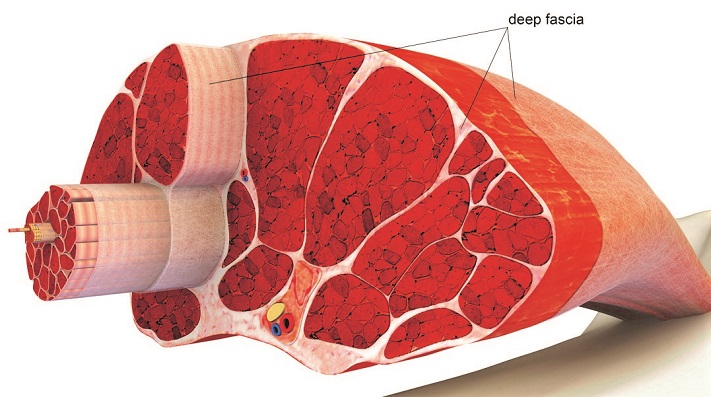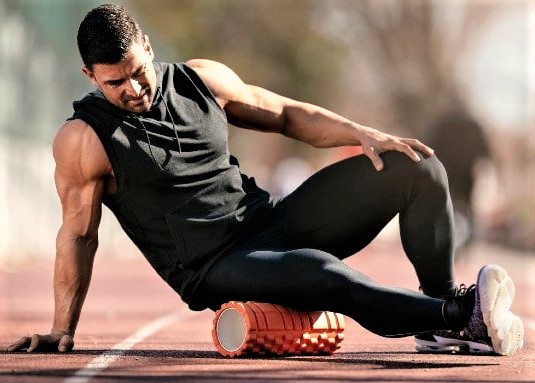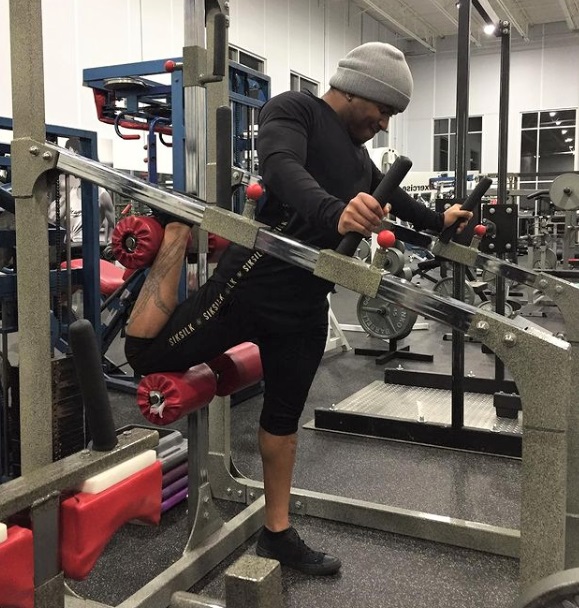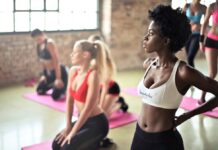Fascia became gym-trendy this century. Massages, rollers, and stretches are used to release its tight hold on your muscles, increase flexibility, and foster exercise recovery, growth, and strength gains. What’s it all about? And how can you loosen your own fascia to relieve tightness, improve performance, and make way for more muscle?
WHAT IS FASCIA?
Fascia is a thin casing of connective tissue that surrounds and holds organs, muscles, bones, blood vessels, and nerve fibers in place. Let’s zero in on muscles. Fascia covers individual muscles, groups of muscle fibers, and muscle fibers. It provides internal structure to muscles, keeping them in place and in their ideal shape, but it also holds nerves.

Because of these nerves, when it’s stressed, from an injury or just a lot of work, fascia tightens up. And when fascia is tight, it can limit the expansion of muscles. Think of the difference between a plastic bag and a Tupperware bowl. The bag can expand to hold more meat because it’s pliable. The bowl can’t expand because it’s rigid. You want your muscle fascia to be more like the bag and less like the bowl.
FASCIA MASSAGE
Myofascial release loosens the muscular fascia to relieve tension and soreness and, hopefully, heighten workout (or injury) recovery and growth. One way to do this is via deep tissue massage. Some bodybuilders regularly get deep tissue massage, in part, to loosen their fascia. But we’re focused here on do-it-yourself fascia stretching. Some bodyparts, like chest, biceps, and quads you can self-massage.
But the best way to target every bodypart is with a foam roller or similar device (including tennis balls and a rolling pin). A review of all relevant studies of “self-myofascial release using a foam roll or roller massager” concluded: “The current literature measuring the effects of SMR [self-myofascial release] is still emerging. The results of this analysis suggests that foam rolling and roller massage may be effective interventions for enhancing joint ROM [range-of-motion] and pre and post exercise muscle performance.”

Foam rollers come in a variety of densities. Soft rollers have a smooth, soft surface and are great for beginners or if you’re nursing a particularly sore bodypart. Deep tissue rollers have extra firm ridges which stimulate deeper layers of muscles, and these are the rollers you’ll want for myofascial release. When the roller is on the floor, you can hit every bodypart by rolling over either face-down or face-up. Using deep tissue rollers should be a little painful, a sign that you’re applying enough pressure to target the muscles and their fascia.
FASCIA STRETCHING
Let’s turn now to actual stretching. There are two kinds: dynamic and static. Dynamic stretches utilize movement. Examples include high kicks and trunk twists. These can increase your mobility, and they should be done as a warmup or between sets. In contrast, static stretches are motionless. Once you’ve positioned yourself properly, you remain locked in place. These stretches should be performed when your tendons and muscles are most pliable. Do them after training a bodypart, not before. Dynamic stretches, when pushed to the point of pain, can expand and loosen the fascia slightly, but that slightly may make a big difference.
Intense static holds may have advantages beyond simply increasing flexibility. Studies with birds indicate that such stretches can cause hypertrophy (growth) and hyperplasia (the splitting and thus multiplication of muscle cells). Studies with humans have shown that stretching makes muscles stronger. (Update: A recent study demonstrated that pectoral intense stretching was as good as weight training for both growth and strength.) One theory proposes that expanding the fascia fosters growth by literally making room for easier expansion. In fact, when this technique was first popularized in the ’90s by trainer John Parrillo, it was named fascia stretching. A fascia stretch puts your muscle into the maximally elongated position and keeps it there, sometimes with slight changes, for 20-60 seconds.

Parrillo said: “You do not loosen fascia with mild stretches. The bodybuilder’s bodyweight or a training partner are used to take you past what you are currently capable of. Only by continually bumping up against the limits is tight fascia made looser.” Of course, you never want to wrench your joints, but you do want to fully stretch. There will be pain. If there’s not, you’re doing it wrong. But if there’s too much pain, signifying injury, you’re also doing it wrong. You want to push far, just up to the limit, but not too far. Fascia stretch therapy (FST) can be performed by a physical therapist. But we’re going to focus on stretches you can do alone. These can be done with weights, equipment like chinning or dipping bars, nothing more than a doorway or floor, or with only your body and your will to self-torment.
FASCIA STRETCHING BASICS
◼️ Stretch a bodypart just after training it.
◼️ Attain the maximally stretched position and hold it for 20-60 seconds.
◼️ Do one or two stretches per body part per workout.
◼️ Such stretches will increase mobility and may also boost growth.
THE FASCIA STRETCHES
CHEST
FLYE STRETCH. Grab two dumbbells that are slightly heavier than those you would use for a set of flyes. Lie on an incline bench and lower the dumbbells as if doing flyes. Go as low as you can go and hold that position, keeping your hands wider than your elbows. When you start to give out, bring your hands in, so you’re mimicking the lowest position in a press. This can also be done on a flat or decline bench.
PEC ROTATION. Press one bent arm against a doorway or vertical bar and revolve your body to maximally tauten the pec. Repeat with the opposite forearm to work the other pec.
BACK
LAT HANG. You can intensely stretch your lats by simply holding onto a chinning bar. Use addition weight if necessary to make it painful to keep hanging.
LAT LEAN. Grip a vertical bar with both hands. Lean backwards so you’re supporting your bodyweight with your lats maximally stretched. Experiment with a low or high grip on the bar and the height of your hips to stretch different areas of your back.
SHOULDERS
BEHIND-THE-BACK DIP. With your arms bent and behind you, hold a Smith machine bar or a barbell in a power rack set two to three feet high. Then bring your shoulders forward as you lower yourself until you feel the maximum stretch in your anterior delts. Hold this position.
QUADRICEPS
ONE-LEG TUCK. Stand, bend one leg completely, and hold the foot behind the glute. Maximize the stretch by pulling the tucked leg backwards until it’s just painful enough. Repeat for the other side.
SQUAT. Grab a stationary bar in front of you set about hip-high and squat all the way down. Then lean back while you bring your knees forward to find the maximum squat position. Hold and embrace the pain.
HAMSTRINGS
HURDLER’S STRETCH. Set a bar in a squat rack or Smith machine at least hip-high, and place one ankle on the horizontal bar. Keeping that leg straight, press down until you reach the point of maximum tension and then hold. Repeat with the other leg.
TOE TOUCH. Keep your legs straight and bend down towards the floor as far as possible. Hold this position.
CALVES
STANDING RISER STETCH. To stretch the gastrocnemius, stand with your toes on a riser, whether at a calf machine or on a block or stair riser, and lower yourself as far down as you can. Hold that position. This can also be done with one leg at a time.
SEATED RISER STRETCH. To stretch the soleus, get to the maximum stretched position in a seated calf machine with weight. Hold that position.
BICEPS
BICEPS ROTATION. Hold a doorway or vertical bar with one hand, and, while keeping that arm straight, rotate your shoulder away until you feel the maximum pressure on your biceps. Repeat for the other arm.
BEHIND-THE-BACK SQUAT. Hold a stationary horizontal bar (a Smith machine works great) behind your lower back and keep your arms straight. Then lower yourself, as if squatting to feel your biceps tauten.
TRICEPS
ONE DUMBBELL. Grab a dumbbell with one hand and lower it behind your head, as if to do a one-arm triceps extension. Go as low as you can go, and hold that position.
DIP. On dipping bars, drop to the lowest dip position while keeping your torso perpendicular to the floor. Hold that stretch and embrace the pain.
FASCIA STRETCHING TIPS
◼️ Don’t place your joints in an unnatural position, but do maximally stretch the targeted muscle(s).
◼️ To be effective, fascia stretching must be somewhat painful, but stop immediately if you feel a sharp or unusual pain.
◼️ Build up your tolerance by gradually increasing the duration of the stretch until you can do 60 seconds.
◼️ Follow each stretch with a deep self-massage of the area.
Related content:
The Science of Stretching: When and How to Stretch for Optimal Benefits
















































